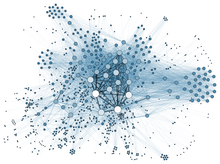Social contagion

Social contagion involves behaviour, emotions, or conditions spreading spontaneously through a group or network. The phenomenon has been discussed by social scientists since the late 19th century, although much work on the subject was based on unclear or even contradictory conceptions of what social contagion is, so exact definitions vary. Some scholars include the unplanned spread of ideas through a population as social contagion, though others prefer to class that as memetics. Generally social contagion is understood to be separate from the collective behaviour which results from a direct attempt to exert social influence.
Two broad divisions of social contagion are behavioural contagion and emotional contagion. The study of social contagion has intensified in the 21st century. Much recent work involves academics from social psychology, sociology, and network science investigating online social networks. Studies in the 20th century typically focused on negative effects such as violent mob behaviour, whereas those of the 21st century, while sometimes looking at harmful effects, have often focused on relatively neutral contagion such as influence on shopping choices, and even on positive effects like the tendency for people to take action on climate change once a sufficient number of their neighbours do.
History

Metaphoric use connecting the concept of infection with imitation (mimesis) dates back at least to Plato, and continued into medieval and early modern literature. The term "behavioural contagion" was first introduced into modern scholarship by Gustave Le Bon in his 1895 book The Crowd: A Study of the Popular Mind. Further scholarly works on the subject were at first released slowly, only one or two a decade until the 1950s. Herbert Blumer was the first to specifically use the term "social contagion”, in his 1939 paper on collective behavior, where he gave the dancing mania of the middle ages as a prominent example. From the 1950s, studies of social contagion began to investigate the phenomena empirically, and became more frequent. There was no widely shared definition of social contagion in the 20th century however, so many of the studies had little in common. In 1993, David A. Levy and Paul R. Nail published a review where they stated that social contagion captures the broadest sense of the phenomena, as opposed to subtypes like behavioural or emotional contagion. In a 1998 review, Paul Marsden suggested that social contagion is a similar phenomena to memetics, a field of study inspired by Richard Dawkins' 1976 book The Selfish Gene. Marsden suggested that the two fields could be complementary, in the sense that work on social contagion largely lacked a coherent theory, but contained much evidence based analyses. Whereas memetics was rich in theory but lacking on the empirical side. From the 1990s and into the 21st century, interest in social contagion grew rapidly, based in part on cross fertilisation with the then emerging field of network science, especially its application to the internet.[1][2][3]
Definition
Scholars have long reported that the study of social contagion has suffered from the lack of a widely accepted and precise definition. Definitions have often, though not always, classified social contagion as a method of transmission that does not rely on a direct intent to influence. Other definitions have suggested that social contagion involves spontaneous imitation of others, rather than being based on conscious decisions.[note 1] In their 1993 review, Levy and Nail proposed that social contagion should be defined as the spread of affect, attitude or behaviour "where the recipient does not perceive an intentional influence attempt on the part of the initiator".[1][3][2][4]
Typology

Various typologies have been proposed for social contagion.[1][2][5]
By what is being transmitted
Social contagion can be broadly split into behavioural contagion and emotional contagion. The spread of ideas is sometimes considered a third broad category, though that is often considered part of memetics. Dr. Paul Marsden has said behavioural contagion can be split into six subcategories: hysterical contagions, deliberate self-harm contagions, contagions of aggression, rule violation contagions, consumer behaviour contagions, and financial contagions.[2][5][3]
By causal pathway
Three main causes of social contagion have been proposed: disinhibitory contagion, echo contagion, and hysterical contagion.[1] Disinhibitory contagion involves a type of behaviour that the person already has some desire to engage in, but from which normally they would refrain due to a desire to comply with social norms. When they witness others in the crowd performing the behaviour, this can break the inhibitory effect.[1] Echo contagion represents the spontaneous imitation of a behaviour, or transition into conformance with an emotional state shared by others.[1] Hysterical contagion represents the unwanted transmission of a behaviour, emotion or affect among a group by unknown means. Unlike with echo or disinhibitory contagion, what is being transmitted may in no way be desirable or attractive, yet it transmits anyway.[1]
By cardinality of exposure
Social contagion can be examined with threshold models based on how much exposure an individual needs before transmission of a behaviour or emotion occurs. Some models assume an individual needs to be convinced by a fraction of their social contacts above a given threshold to adopt a novel behaviour.[6] Therefore, the number of exposures will not increase chances of contagion unless the number of source exposures pass a certain threshold. The threshold value can divide contagion processes to two types: simple contagion and complex contagion.[7][8] In simple contagion, an individual only needs a single exposure to the new behaviour. For instance, cars travel in groups on a two-lane highway since the car in each cluster travels at a slower speed than the car behind it. This relative speed spreads through other cars who slow down to match the speed of the car in front.[6] In complex contagion, the individual needs to be in contact with two or more sources exhibiting the novel behaviour.[9] This is when copying behaviours needs reinforcement or encouragement from multiple sources. Multiple sources, especially close friends, can make imitation legitimate, credible and worthwhile due to collective effort put in. Examples of complex contagions include a New York University School of Business study in California which found that households were more likely to install solar panels in neighborhoods that already had them, and that the rate of installation increases with more and more installations, creating a chain reaction that added up to a significant increase in solar adoption.[10] Other examples can be copying risky behaviour or joining social movements and riots.[7]
Positive contagions
Much early work on social contagion looked only at harmful effects, in keeping with the infectious disease metaphor. Yet towards the end of the 20th century, and especially in the 21st, scholars began to look at neutral and positive contagion. For example, the rippling of happiness through a social network, up to three degrees of separation from the initiator. The contagion effect of happiness is also strongly influenced by physical proximity. Research based on the Framingham Heart Study found that if one has a happy friend living no more than a mile away, they are 25% more likely to be happy, whereas one is 34% more likely to be happy with a happy next-door neighbour.[11] Work has been done to understand social contagion as a way to encourage positive behaviour, as a possible complement to nudge theory. It has been suggested as a way to assist in the rehabilitation of criminals and drug addicts, and as something that can encourage the adoption of climate friendly behaviour. Such as the increased tendency to install solar panels on one's personal home once a portion of one's neighbours have already done so.[12][13][14]
Mental health
Inside the scientific community the influence of social contagion of mental disorders like anxiety and depression is a topic of debate.[15]
Claims about social contagion of gender dysphoria have led to a rapid-onset gender dysphoria controversy.
Criticism
The field of social contagion has been repeatedly criticized for lacking a clear and widely accepted definition, even though any area of research is marked by definitional variation, and for sometimes involving work that does not distinguish between contagion and other forms of social influence, like command and compliance, or from the otherwise also diffuse concept of homophily.[4] In social network analysis and related network science fields, the contagion metaphor has been described as potentially misleading in various ways. For example, an actual virus can affect someone after a single exposure, whereas typically with social contagion, people need several exposures before adopting the new behavior or emotion.[16] Some scholars (e.g., Ralph H. Turner) have suggested that certain types of collective behaviour are better understood by emergent norm theory or convergence theory, rather than by social contagion.[2]
See also
- Copycat crime
- Copycat suicide
- Conformity
- Cultural assimilation
- Mass psychogenic illness
- Peer contagion
- Social proof
Notes
- ^ Though some definitions have stated that contagion is distinct from imitation, see Levy and Nail (1993).
References
- ^ a b c d e f g David A. Levy , Paul R. Nail (1993). "Contagion: A Theoretical and Empirical Review and Reconceptualization". Genetic Social and General Psychology Monographs. 119 (2): 233–84. PMID 8405969.
- ^ a b c d e Paul Marsden (1998). "Memetics and Social Contagion: Two Sides of the Same Coin?". Journal of Memetics. 2 (2): 171–185.
- ^ a b c Peta Michell (2012). "1, 3". Contagious Metaphor. Bloomsbury Academic. ISBN 978-1472521620.
- ^ a b Cosma Rohilla Shalizi, Andrew C. Thomas (2011). "Homophily and Contagion Are Generically Confounded in Observational Social Network Studies". Sociological Methods & Research. 40 (2): 211–239. doi:10.1177/0049124111404820. PMC 3328971. PMID 22523436.
- ^ a b Stephen G. Harkins; Kipling D. Williams; Jerry M. Burger, eds. (2017). "7 , 23". The Oxford Handbook of Social Influence. Oxford University Press. ISBN 978-0199859870.
- ^ a b Centola, Damon; Macy, Michael (2007). "Complex Contagions and the Weakness of Long Ties". American Journal of Sociology. 113 (3): 702–734. doi:10.1086/521848. JSTOR 10.1086/521848. S2CID 7298238.
- ^ a b Centola, Damon; Macy, Michael (2007). "Complex Contagions and the Weakness of Long Ties". American Journal of Sociology. 113 (3): 702–734. doi:10.1086/521848. JSTOR 10.1086/521848. S2CID 7298238.
- ^ Böttcher, L.; Nagler, J.; Herrmann, H. J. (23 February 2017). "Critical Behaviors in Contagion Dynamics". Physical Review Letters. 118 (8): 088301. arXiv:1701.08988. Bibcode:2017PhRvL.118h8301B. doi:10.1103/PhysRevLett.118.088301. PMC 7219437. PMID 28282207.
- ^ Iacopini, Iacopo; Petri, Giovanni; Barrat, Alain; Latora, Vito (2019). "Simplicial models of social contagion". Nature Communications. 10 (1): 2485. arXiv:1810.07031. Bibcode:2019NatCo..10.2485I. doi:10.1038/s41467-019-10431-6. PMC 6554271. PMID 31171784.
- ^ Einhorn, Laura. "Normative Social Influence on Meat Consumption". MPG.PuRe. Max Planck Society. Retrieved 22 February 2024.
- ^ Robin Dunbar; Danilo Bzdok (2020). "The Neurobiology of Social Distance". Trends in Cognitive Sciences. 24 (9): 717–733. doi:10.1016/j.tics.2020.05.016. PMC 7266757. PMID 32561254.
- ^ David Best (2019). "8, passim". Pathways to Recovery and Desistance: The Role of the Social Contagion of Hope. Policy Press. ISBN 978-1-4473-4930-3.
- ^ Nicholas Christakis; James H. Fowler (2013). "Social contagion theory: examining dynamic social networks and human behavior". Statistics in Medicine. 32 (4): 556–577. doi:10.1002/sim.5408. PMC 3830455. PMID 22711416.
- ^ Per Espen Stoknes (September 2017). How to transform apocalypse fatigue into action on global warming. TED (conference). Retrieved 6 March 2021.
- ^ Eisenberg, Daniel; Golberstein, Ezra; Whitlock, Janis L.; Downs, Marilyn F. (August 2013). "SOCIAL CONTAGION OF MENTAL HEALTH: EVIDENCE FROM COLLEGE ROOMMATES: CONTAGION OF MENTAL HEALTH". Health Economics. 22 (8) (published 11 October 2012): 965–986. doi:10.1002/hec.2873. PMC 4381550. PMID 23055446.
- ^ Ryan Light and James Moody, ed. (2021). "16". The Oxford Handbook of Social Networks. Oxford University Press. ISBN 978-0190251765.
Further reading
- Lee Daniel Kravetz (2017). Strange Contagion: Inside the Surprising Science of Infectious Behaviors and Viral Emotions and What They Tell Us About Ourselves. Harper Wave. ISBN 978-0062448934.


